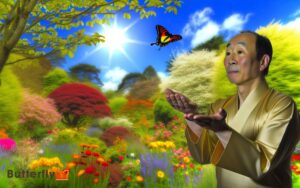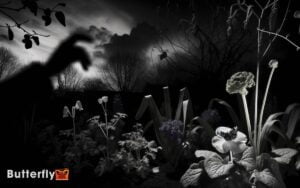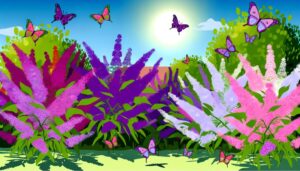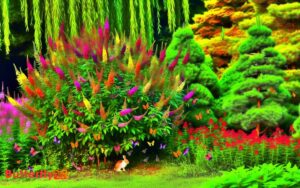How Rare Is A Black Butterfly? Unveiling the Mystery!
Encountering a black butterfly isn’t very common. Species like the Black Swallowtail are rare due to their specific habitat needs and complex genetic traits.
These butterflies thrive in meadows, gardens, and parks but require host plants like parsley and dill. Their dark coloration serves as camouflage and mimicry for survival.
Warmer months increase their activity, making sightings more likely. However, habitat loss and climate change threaten their populations.
Conservation efforts, such as habitat restoration and reducing pesticide use, are essential. If you’re curious about their remarkable adaptability and ecological roles, there’s much more to discover about these fascinating insects.
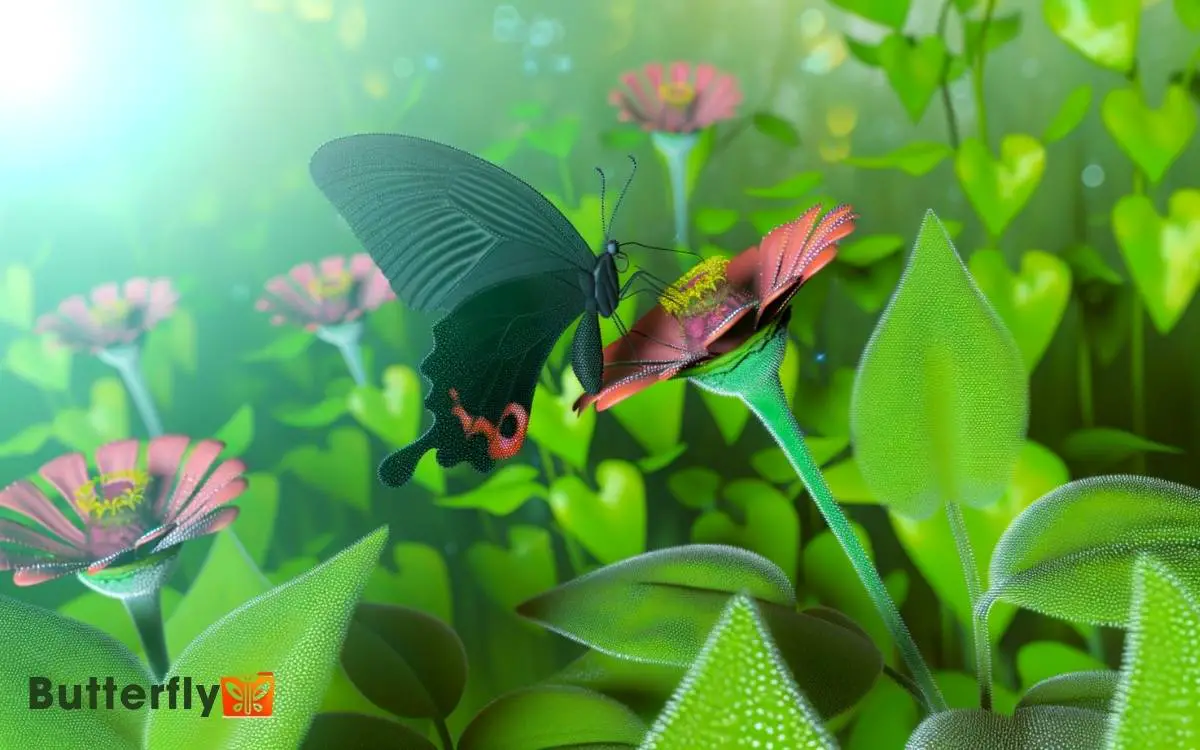
Key Takeaways
Black Butterfly Species
Among the most striking black butterfly species you might encounter is the Black Swallowtail (Papilio polyxenes), known for its velvety black wings adorned with intricate yellow and blue patterns.
You’ll notice the distinctive tails on their hindwings, resembling delicate swallow tails, which serve both aesthetic and aerodynamic purposes.
These butterflies exhibit sexual dimorphism; females typically display more pronounced blue markings, enhancing their visual appeal.
The Black Swallowtail’s wing patterns aren’t only visually stunning but also serve as a defense mechanism, mimicking the toxic Pipevine Swallowtail to deter predators.
Habitat and Distribution
Black Swallowtails inhabit diverse environments, ranging from open meadows and fields to suburban gardens and even urban parks, where they thrive on a variety of host plants like parsley, dill, and fennel.
You’ll find them mainly in North America, but their adaptability allows them to colonize both rural and urban areas. These butterflies are especially common in regions with temperate climates, facilitating multiple generations per year.
Their distribution isn’t confined to natural settings; they’ve successfully integrated into human-modified landscapes. Urban green spaces, rooftop gardens, and community plots provide essential resources for their survival.
Genetic Factors
Understanding their adaptability to various environments requires examining the genetic factors that contribute to the resilience and versatility of Black Swallowtails.
Their remarkable adaptability stems from genetic polymorphism, which allows for diverse physical traits. These traits, including wing coloration and pattern, are controlled by multiple genes that interact in complex ways.
Genetic variance guarantees that some individuals possess traits making them more suited to specific environments.
The presence of melanin in their wings, regulated by specific alleles, grants them an edge in thermoregulation and camouflage. Additionally, genetic mutations can lead to the emergence of new traits, enhancing survival rates.
Seasonal Variations
You’ll notice that the rare black butterfly is most commonly sighted during specific seasons, influenced notably by migratory patterns. These patterns are in turn affected by climate impact trends, which can shift the timing and locations of their appearances.
Understanding these seasonal variations requires a detailed analysis of environmental factors and their direct effects on butterfly behavior. Temperature, humidity, and food availability all play crucial roles in shaping their feeding patterns and migration cycles. Butterfly mouth anatomy also influences how different species adapt to seasonal changes, as their specialized proboscis determines their ability to access nectar from various flowers. By studying these factors together, researchers can better predict how butterfly populations respond to environmental shifts over time.
Common Sightings Seasons
During the warmer months of spring and summer, you’ll frequently spot the rare black butterfly flitting through gardens and meadows.
These seasons provide ideal conditions for their activities, including:
- Temperature: Warmer temperatures enhance metabolic rates, making them more active.
- Floral Availability: Spring and summer blooms offer abundant nectar sources.
- Mating Period: These seasons coincide with their mating cycles, increasing sightings.
- Extended Daylight: Longer daylight hours allow more time for foraging and mating.
Migratory Patterns Influence
Despite their frequent spring and summer appearances, the rare black butterfly‘s migratory patterns also play a significant role in their seasonal distribution. You’ll find these butterflies inhabiting specific regions based on resource availability and environmental cues.
During migration, they follow precise thermal currents and wind patterns, optimizing energy expenditure.
Migration routes can span thousands of miles, with butterflies often traveling at altitudes of up to 3,000 feet. This strategic movement allows them to exploit seasonal abundances in food and breeding grounds.
It’s essential to understand that these migratory patterns aren’t random; they’re finely tuned to environmental changes, ensuring survival and reproduction. By studying these patterns, you can gain insights into ecological balance and develop innovative conservation strategies.
Climate Impact Trends
Changes in climate patterns greatly impact the rare black butterfly’s life cycle, affecting their migration, breeding, and survival rates. You’ll notice how seasonal variations disrupt their delicate balance.
Here are four key effects:
- Altered Migration Routes: Shifts in temperature zones force them to adapt, often leading to higher mortality.
- Breeding Season Changes: Unpredictable weather can misalign their reproductive cycles with best conditions, reducing population growth.
- Habitat Loss: Rising temperatures and changing precipitation patterns shrink their natural habitats, making survival more challenging.
- Food Source Scarcity: Climate-induced changes in flora affect the availability of nectar, important for their sustenance.
Understanding these impacts helps drive innovative conservation strategies, ensuring the survival of these remarkable creatures.
Predators and Survival
The rare black butterfly employs a range of adaptive strategies to evade its predators, enhancing its chances of survival in the wild. You’ll find that this butterfly leverages its dark coloration for camouflage, blending seamlessly into shadowy environments.
Additionally, it exhibits mimicry, resembling toxic species to deter potential threats. This strategic mimicry is crucial in confusing predators like birds and lizards.
Here’s a quick look at some key adaptive strategies:
| Strategy | Function |
|---|---|
| Camouflage | Blends into dark environments |
| Mimicry | Resembles toxic species |
| Rapid Flight | Evades predators through swift escape |
Understanding these strategies can inspire innovative approaches to biomimicry in technology and materials science, underscoring the butterfly’s role in ecological survival.
Cultural Significance
You’ll find the rare black butterfly holds rich cultural significance across various societies. It often appears in mythology and symbolism, representing transformation and mystery, while spiritual interpretations consider it a messenger or harbinger of change.
Additionally, its striking appearance has inspired numerous artistic endeavors, reflecting its profound impact on human creativity.
Mythology and Symbolism
Throughout history, black butterflies have captivated various cultures, symbolizing transformation, mystery, and the presence of the supernatural. Their enigmatic allure has woven them into numerous mythologies and symbolic frameworks.
You’ll find that black butterflies represent:
- Transformation: In many cultures, they signify metamorphosis, indicating a major life change or personal growth.
- Mystery: Their dark hue often associates them with the unknown, encouraging curiosity and exploration.
- Supernatural: In folklore, they’re seen as messengers from the spirit world, bridging the gap between dimensions.
- Protection: Some traditions believe black butterflies ward off evil spirits and bring protection to those they visit.
Understanding these symbolic meanings can enrich your appreciation for these rare and fascinating creatures.
Spiritual Interpretations
Building on their rich symbolism, black butterflies also hold profound spiritual interpretations across various cultures, often seen as harbingers of transformation and messages from the divine.
In many traditions, encountering a black butterfly signals impending change or a spiritual awakening. They’re considered messengers bridging the physical and ethereal planes.
In Shamanic practices, black butterflies symbolize the soul’s journey through darkness towards enlightenment, urging you to embrace inner transformation.
Some cultures view them as omens of protection, guiding you through life’s uncertainties. Their rarity only amplifies their spiritual significance, prompting deep introspection and a connection to higher consciousness.
Artistic Inspirations
Artists across various cultures have long drawn inspiration from the rare black butterfly, weaving its enigmatic beauty and symbolic depth into their works.
You’ll find this elusive creature prominently featured in several artistic domains:
- Visual Arts: Painters use the black butterfly to symbolize transformation and mystery, often placing it in surreal, dreamlike landscapes.
- Literature: Poets and novelists invoke its image to explore themes of rebirth, the unknown, and the intersection of light and darkness.
- Fashion: Designers incorporate its motifs into haute couture, emphasizing elegance and the allure of the exotic.
- Cinema: Filmmakers use it as a visual metaphor for change, often signaling pivotal moments in a character’s journey.
Each medium captures the black butterfly’s rare allure, making it a powerful symbol of innovation.
Symbolism in Art
When you examine the intricate details of various art forms, the rare black butterfly often emerges as a profound symbol of transformation, mystery, and the ephemeral nature of beauty.
Artists leverage its unique coloration to evoke a sense of enigma and elegance. In surrealist paintings, the black butterfly may represent the unknown, bridging the conscious and subconscious domains.
In digital art, its iridescent hues can symbolize innovation and the fleeting moments of inspiration. Sculptors might use it to convey metamorphosis, capturing the delicate balance between fragility and strength.
Conservation Status
While the rare black butterfly captivates artists and admirers alike, it’s imperative to address its conservation status, highlighting the urgent need for protective measures to ensure its survival in the wild.
You should understand that habitat loss, climate change, and pesticide use threaten these delicate creatures. Without intervention, their populations could decline rapidly.
Consider these vital steps for conservation:
- Habitat Restoration: Rehabilitate natural habitats to support breeding and feeding.
- Legislation: Advocate for laws that protect butterfly habitats from urban development and deforestation.
- Pesticide Regulation: Implement stricter controls on pesticide use to limit harmful chemical exposure.
- Public Awareness: Educate communities on the importance of butterflies and how to create butterfly-friendly environments.
Observing in Nature
When you’re observing the rare black butterfly in its natural habitat, focus on regions with dense, humid forests, as these environments provide the ideal conditions for their survival.
You’ll notice that their sightings align with specific seasonal patterns, especially during the late spring and early summer when their activity peaks.
Natural Habitat Preferences
A rare black butterfly thrives in specific microclimates, often favoring densely forested areas with high humidity and abundant nectar sources. When searching for these elusive creatures, you should focus on areas where their natural preferences are met.
Consider the following critical habitat elements:
- Dense Vegetation: Look for forested regions with thick underbrush, providing shelter and food.
- Water Sources: Proximity to streams or ponds secures the necessary humidity levels.
- Floral Diversity: A variety of flowering plants supplies the nectar they need for energy.
- Shade: These butterflies often rest in shaded spots to avoid direct sunlight and conserve moisture.
Seasonal Sightings Trends
Understanding the natural habitat preferences of the rare black butterfly can inform you about the best times of year to spot these elusive insects in their favored environments.
Observations indicate that black butterflies are more prevalent during the late spring to early summer months when temperatures are ideal for their activity.
They thrive in regions with dense foliage and abundant nectar sources. Monitoring weather patterns and regional plant blooming cycles can greatly enhance your chances of sighting.
Utilize high-resolution cameras and GPS tracking to document sightings, and consider collaborating with local entomologists to share data.
Encouraging Local Populations
To effectively encourage local populations of the rare black butterfly, implementing targeted habitat restoration and conservation strategies that address the specific ecological needs of the species is crucial.
By focusing on these critical areas, you can enhance their survival chances:
- Native Plant Cultivation: Plant native flora that provides nectar and larval host plants to support various life stages of the black butterfly.
- Pesticide Reduction: Minimize or eliminate the use of pesticides, which can be detrimental to both adult butterflies and caterpillars.
- Habitat Corridors: Establish green corridors to connect fragmented habitats, allowing butterflies to move freely and expand their range.
- Public Engagement: Educate local communities about the importance of butterfly conservation and how they can create butterfly-friendly gardens.
Conclusion
So, how rare is a black butterfly in your neck of the woods?
By understanding their unique species, habitats, and genetic makeup, you’ll appreciate their seasonal appearances and survival strategies.
Their symbolic significance in art and conservation status underscores the importance of protecting these enigmatic insects.
Next time you’re out in nature, keep an eye out and consider ways to encourage local black butterfly populations.
You’ll be contributing to their fascinating and delicate ecosystem.

